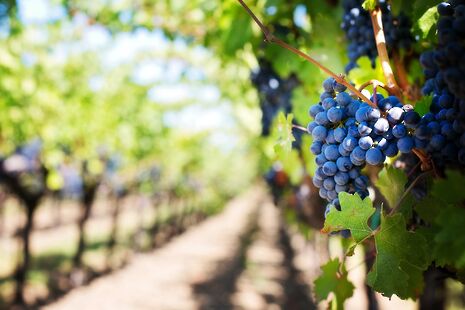The greatest of the grapes
Edward Pinnegar navigates the maze of grape terminology

The ability to navigate the labyrinthine maze of grape terminology, or just knowing what on earth anyone’s on about, seems enticing until – after a couple of seconds of mulling over the prospect – you realise that knowing the difference between Pinot Grigio and Pinot Gris (they’re the same!) would be somewhere between self-righteous and dull
"Nobody has a clue how many grape varieties there are in the world"
So no need. In fact, nobody has a clue how many grape varieties there are in the world: minor differences between sub-sub-sub-species (or something like that – sorry NatScis) mean this is basically an exercise in semantics, but there are somewhere between 2,000 and 10,000 worldwide, of which around 1,200 are used to make wine commercially.
You’ll never get your head around them all, and nobody ever has, so here’s a list of just four grapes I’d recommend, which are either a bit off the beaten track or too-good-to-miss, with some ideas for what to drink this week.
Verdejo/Verdelho (white)
Grown in Spain and Portugal – hence the different spellings – originally in Madeira and in Reuda (central Spain), but now just as commonly in Australia, in my view this is unbelievably under-rated. It’s used to make everything from white Port to dry whites, which taste light and fruity when they’re young – you might pick up some citrus-y, almost salad-y flavours. But age some Verdejos for a few years and a richness emerges – but with more flavours and nuance than typically expensive, ‘big’ white wines, which are often made of Chardonnay grapes. The best of both worlds, a bit like Viognier.
Your best bet is the Cal y Canto Verdejo 2018 Tierra de Castilla, available from Cambridge Wine Merchants for £5.40 (with 10% student discount). Serve pretty chilled, on its own or with fish/seafood.
If it were human it’d be: introverted but interesting
Chardonnay (white)
Basic, yes. Classic, yes. You can’t really go wrong with this crowd-pleaser of a grape. Sometimes you hear people describing whites – and particularly Chardonnays – as ‘buttery’. This is quite right: Chardonnay under fermentation tends to develop higher levels of a chemical called diacetyl (C4H6O2… apparently) which gives butter its flavour. It sounds like a nerve agent, but it’s actually a by-product of ‘malolactic’ fermentation, whereby malic acid (which is often associated with sharp, green apples) transforms into richer flavoured lactic acid, all thanks to a wonderfully named bacteria called Oenococcus oeni. Anyway, Chardonnay is very tasty, it’s grown basically everywhere, and you should drink lots of it. In moderation, of course.
I recommend the Dom. Gayda Cepage Chardonnay 2017 IGP Pays d’Oc, available from the Cambridge Wine Merchants for £8.22 (with 10% student discount). Both Sainsbury’s and CWM stock plenty of Chardonnays for less, and Sainsbury’s Macon Villages, Taste the Difference (£8) is a good vegan alternative.
If it were human it’d be: totally devoid of any principles whatsoever
Mourvèdre (red)
The great Jancis Robinson, perhaps the world’s most wholesome wine critic and author of an excellent wine columnin the FT (if you’re a Cambridge student you can read it for free!), describes Mourvèdre as ‘long either despised or ignored’. Indeed it was – but since the 1980s it’s had a bit of a renaissance.
It’s the diva of the wine world: like most Cambridge students in Lent, it needs TLC and hot weather to avoid succumbing to mildew or frost. Too little oxygen during the winemaking process can even make it taste a bit egg-y. This is rare, and wine-makers have it mostly sussed, but if it does happen, some weird chemistry means you stand a good chance of fighting this odd little quirk by throwing a copper coin or two (1ps or 2ps are best) into the offending glass. But when it’s good, it’s very good, producing dark, rich, almost gamey reds.
The need for heat means it’s most commonly grown in southern France, Spain (as Monastrell) Australia (as Mataro). Most often it’s blended with Grenache, another under-rated red, and Shiraz/Syrah.
A good bet is Cambridge Wine Merchants’ Magpie Estate The Scoundrel Grenache Mouvedre Shiraz 2015, Barossa Valley, at £8.88 (with 10% student discount). Again, a bit pricey for student wine, but Mourvèdre’s a relatively rare beast (even in a blend as here), and this is a proper winter red. It also has a fantastic label featuring a seemingly alcoholic magpie, which is fun. Sainsbury’s Cellier Des Dauphins Merlot Grenache has a sort-of-similar vibe at £5.75.
If it were human it’d be: a big character, but diminished without its siblings. Liam Gallagher post-Oasis?
Pinot noir (red)
Pinot noir is far less concentrated than ‘big’ reds like Riojas or even classic Cabernets, can be drunk a bit cooler and with just about anything (including fish), won’t feel like a meal in itself, and in a bit of moderation won’t give you that typical ‘red wine’ hangover.
However, if Mourvèdre is a diva, Pinot noir is a pain in the arse. It’s vulnerable to rot, and the grapes’ thin skins make their wines’ chemistry unpredictable. But clever people have spent lots of time working out an appeasement policy and Pinot noir has broken out of its traditional territory (in France’s Burgundy) and travelled all over the New World.
Because it cares inordinately about how and where it’s planted, and what you do with its grapes, there’s a lot of trash about that just isn’t worth your cash. Cambridge Wine Merchants’ Calusari Pinot Noir 2018 (£6.54 with 10% student discount) is a great value example from Romania. Sainsbury’s House Pinot Noir (£4.80) is less interesting than its Coolwater Bay Taste the Difference (£7.50, reduced from £9.50), but both are vegan.
If it were human it’d be: moody but talented. Who knew Liam Gallagher had so much in common with wine
 News / Caius mourns its tree-mendous loss23 December 2025
News / Caius mourns its tree-mendous loss23 December 2025 News / Clare Hall spent over £500k opposing busway 24 December 2025
News / Clare Hall spent over £500k opposing busway 24 December 2025 Comment / The ‘class’ of Cambridge24 December 2025
Comment / The ‘class’ of Cambridge24 December 2025 Comment / Yes, I’m brown – but I have more important things to say22 December 2025
Comment / Yes, I’m brown – but I have more important things to say22 December 2025 Interviews / Politics, your own way: Tilly Middlehurst on speaking out21 December 2025
Interviews / Politics, your own way: Tilly Middlehurst on speaking out21 December 2025








